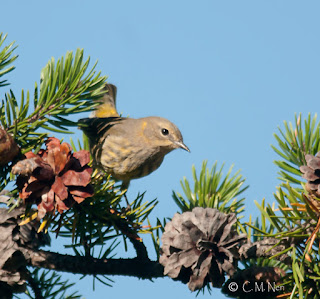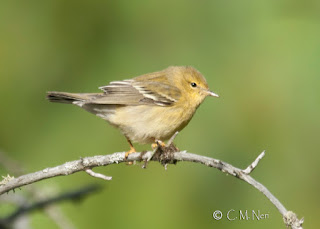Highlights: Yellow-headed Blackbird & nice warbler migration
Despite pretty unfavorable weather conditions there has been decent activity in the woods the last few days. However, the highlight was not in the woods, but a Yellow-headed Blackbird found by Eric out at the Point during the waterbird count on 9/3. The weather has stalled the waterbird flight down for Eric the last few days, but on the third he had over 2, 400 Red-necked Grebes, almost 100 Common Loons and a few Red-throated Loons along with a nice mix of other waterbirds for this time in the season. As always you can check out Eric's post on the waterbird blog Off WPBO's website for more details.
The majority of the activity in the woods has been provided by warblers, Cedar Waxwings and Red-breasted Nuthatches. There are regularly flocks of 10-30 waxwings feeding at scattered locations in the woods wherever berries are present. The nuthatch numbers have been increasing the last few days. As those of you who are familiar with birding the Point now, it can be difficult to get an accurate count on birds like nuthatches here, but they were joining in with the warbler flocks today and it was common to see 20-30 moving in waves through the trees. The warbler migration has remained somewhat surprisingly good considering the recent weather pattern. Seventeen species have been observed in the last few days. As is to be expected Yellow-rumped and Nashville have been the most common species. You can usually find a few Blackpoll, Tennessee and Black-throated Greens mixed in with the bigger flocks. Other recent warbler sightings included Mourning, Cape May, Bay-breasted, Northern Parula, Chestnut-sided and Blackburnian (surprisingly uncommon here in the fall). Other recent sightings in the woods have included Ruffed Grouse, Philadelphia, Blue-headed and Red-eyed Vireos, Brown Creeper, Scarlet Tanager and Purple Finch. We've also been hearing flocks of Red Crossbills with some regularity the last few days, the largest flock seen was 17 birds.

American Redstart with a Daddy Longlegs meal.
Many of us, perhaps most, associate birding during this this time of the year with confusing fall warblers, as well we should. A sighting the other day reminded me of when I got absolutely stumped during my first fall here back in 2004. I had already spent three springs here at that time and was familiar with all of the warbler species that regular occur here. I knew there would be some tricky birds and I would have to let some go unidentified. However, I did not think I would draw a complete blank on a bird that I got great looks at that, as it turned out, I had seen many times here before. I was standing along the bayside tree line sorting through a warbler flock, "Yellow-rumped, Yellow-rumped, Nashville, Yellow-rumped, Blackpoll, huh?.........." The bird teed up beautifully and all I could think was, "Man, that is a drab warbler." I was able to keep up with the bird as it worked down the tree line and had several more perfect, long looks in great light before I finally lost it. It was gone and I stood there with my head tilted, mouth slightly open, staring into nowhere with a blank expression, yeah I had put my stupid face on.
My first impression had been that it was a very drab, plain tan warbler with no strong field marks. After having been afforded several more great looks I concluded that it was a very drab, plain tan warbler with no strong field marks. Although there were no strong field marks, there were some weak ones; it was chunky for a warbler, had two weak wingbars, a pale somewhat broad supercillium, a weak cheek patch and a slightly broken eyering. This was enough to figure it out when I later sat down with a field guide and used the process of elimination. It turned out to be a very drab 1st fall Pine Warbler like the one pictured below. These birds are here in the fall and I saw three of them the other day. My first reaction is still, "Man, that is a dull warbler."
Pine Warbler
I guess the point of that story is that there are many ways for us to help ourselves improve our identification skills. When we are studying our field guides trying to learn our warblers it is very natural to focus on strong field marks like bright colors, bold white wingbars or a strong eyering. It is also natural to be better at retaining field marks on birds we really hope to see. I doubt any of us have seen a bird like this Pine Warbler in a field guide and thought, "Wow, I'd love to see that!" The thing is, when your in the field and a bird pops up point blank and gives repeated great looks it is really annoying to have no idea what it is. It wasn't long before I saw another Pine Warbler like this. My immediate reaction was still, "Man, that is a dull warbler." I started to get my stupid face out and then quickly realized I was having the same reaction to seeing the same bird that I had just a few days earlier. Learning to recognize this was always my response to seeing this bird helped me begin to identify them much more quickly. The lack of strong field marks can be as effective in helping us identify a bird as the presence of strong field marks can be. Learning to recognize our own first response to seeing a dull warbler like this can be very effective in helping us put a name to it. So if you come to the Point soon and are sorting through a flock of warblers when the drabbest warbler you have ever seen pops up ask yourself, "Is it a Pine Warbler?" If the answer is yes you can wipe that stupid look off your face, check Pine Warbler off your trip list and start looking for a pretty warbler.

Black-throated Green Warbler
Another thing to be aware of at the Point right now is that there are still juvenile warblers that have not even finished molting into their confusing fall plumage. During the summer we see juvenile warblers that are not pictured in field guides and are far harder to figure out than they are in the fall. The above Black-throated Green was photographed today and was still molting in the yellow in the face, the green on the back, the streaks on its flanks and its white wingbars.
Cicada
The butterflies have been a bit disappointing but there are a few around. I saw just my third Striped Hairstreak ever at the Point a few days ago. Northern Pearly-eyes can be relatively common here, but one today was the first I've seen this year.
Striped Hairstreak
Northern Pearly-eye
Chris Neri


































